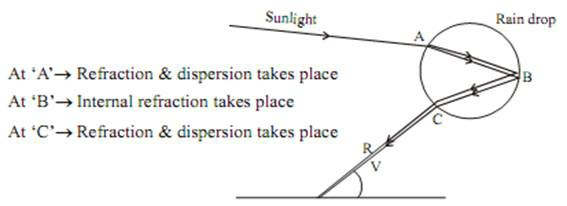
Some Atmospheric Refraction Natural Phenomenon
Rainbow
It is the spectrum of sunlight in nature It is formed due to the dispersion of sunlight by the tiny water droplet, present in the atmosphere.
Water Droplet Act like Prism
It refracts and disperses the incident sunlight, then reflects it internally(internal reflection) and finally refracts it again, when it emerges out of the water droplet. A rainbow is always formed in a direction opposite to that of the sun. Due to dispersion and internal reflection of light, different colours reach the observer’s eye. Red colour appears on top & violet at the bottom of the rainbow.

Apparent Star Position
- It is due to atmospheric refraction of starlight.
- The temperature and density of different layers of atmosphere keep varying. Hence we have a different medium.
- Distant star act as a point source of light. When the starlight enters the earth’s atmosphere it undergoes refraction continuously, due to changing refractive index i.e. from Rarer to denser, it bends towards the normal.
- Due to this, the apparent position of the star is different from the actual position.
- The star appears higher than its actual position.

The twinkling of Star:
- It is also due to atmospheric refraction.
- Distant star act like a point source of light. As the beam of starlight keeps deviating from its path, the apparent position of star keeps on changing because physical condition of earth’s atmosphere is not stationary
- Hence the amount of light enters our eyes fluctuate some time bright and sometimes faint.
This is the “Twinkling effect of the star”.
Blue Sky
The blue color of the sky is caused by the scattering of sunlight off the molecules of the atmosphere. This scattering, called Rayleigh scattering, is more effective at short wavelengths (the blue end of the visible spectrum). Therefore the light scattered down to the earth at a large angle with respect to the direction of the sun’s light is predominantly in the blue end of the spectrum.

